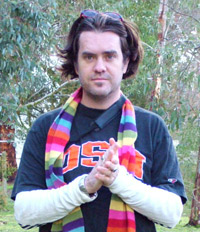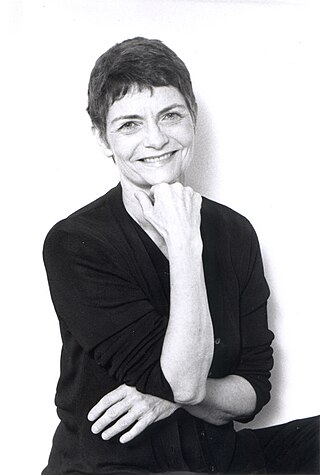Mez Breeze | |
|---|---|
| Nationality | Australian |
| Occupation(s) | Artist and practitioner of net.art |
Mez Breeze is an Australian-based artist and practitioner of net.art, [1] working primarily with code poetry, electronic literature, mezangelle, and digital games. Born Mary-Anne Breeze, she uses a number of avatar nicknames, [2] including Mez [3] and Netwurker. [4] She received degrees in both Applied Social Science [Psychology] at Charles Sturt University in Bathurst, Australia in 1991 and Creative Arts at the University of Wollongong in Australia in 2001. In 1994, Breeze received a diploma in Fine Arts at the Illawarra Institute of Technology, Arts and Media Campus in Australia. As of May 2014, Mez is the only Interactive Writer and Artist who is a non-USA citizen to have her comprehensive career archive (called "The Mez Breeze Papers") housed at Duke University, through their David M. Rubenstein Rare Book & Manuscript Library. [5]
"Mez does for code poetry as jodi and Vuk Ćosić have done for ASCII Art: Turning a great, but naively executed concept into something brilliant, paving the ground for a whole generation of digital artists."
— Florian Cramer [6]
Breeze developed, and continues to write in, the hybrid language mezangelle. Her unorthodox use of language demonstrates the ubiquity of digitisation and the intersections of the digital and the real that are increasingly common in 21st century life. As well as creating static literary texts using mezangelle, Breeze also creates multi-disciplinary multimedia works online, and participates in online happenings that blur the lines between on- and off-line behaviour.
"These works are not content to let code remain below the surface but rather show it erupting through the surface of the screen to challenge the hegemony of alphabetic language."
Mezangelle is a type of poetry Breeze developed in the 1990s using Internet text language found in ASCII codes, online games, and other forms of Internet communication. [8] For example, Breeze titled her 2022 work "[Por]TrAIts" where the capitalization of AI represents the subject of the book (a collaboration between a human and an AI writer). "Mezangelle" refers both to the works themselves and the hybrid language in which they are composed—codeworks of this sort "playfully utilize programming terminology and syntax" [9] alongside "human-only" or so-called natural language, creating a creolised language that combines human language and code. In these works, the primary message is semantically overcoded in such a way that multiple different readings are made possible. For example, the word 'mezangelle' itself is sometimes written as 'm[ez]ang.elle', [10] which itself demonstrates the ways in which punctuation and non-alphabetical symbols (in this case the period and square brackets) disrupt and erupt through the human readable language. The word "mezangelle", itself a neologism, is fractured into multiple fragments that may allude to the words '"Mez", "ez" (easy), "mangle", "angle", "angel", and "elle", along with many possible others. [11] This hybridisation of human-only and digital languages demonstrates both the reliance of human language upon connotation and context, and the inclusion of code in everyday digital communications. Breeze also creates games in which texts in mezangelle are combined with images and sound. [12] These works are often fragmentary or chaotic, as they rely both upon the polysemic nature of mezangelle and the inherent possibilities of computer programming for the display of dynamic audiovisual elements.
Breeze also explores and exploits environments that involve online socialisations or encounters. [13] Such encounters involve the modification of online gaming environments, such as World of Warcraft, [14] EVE Online, and social networking and alternate gaming software. [15] As a member of the online group Third Faction, [16] Breeze has been involved in a number of in-game projects within World of Warcraft, with the aim of disrupting and challenging the combative structure of the game. In this way, Breeze challenges the assumed binary division between the online environment and the real world, and acts to subvert the factionalised “confrontational player-vs-player interaction” [14] that the game world tries to enforce. Breeze's use of multiple avatars for her digital works further emphasises the breakdown of the division between digital and real selves.
Digital poetry is a form of electronic literature, displaying a wide range of approaches to poetry, with a prominent and crucial use of computers. Digital poetry can be available in form of CD-ROM, DVD, as installations in art galleries, in certain cases also recorded as digital video or films, as digital holograms, on the World Wide Web or Internet, and as mobile phone apps.
mezangelle is a poetic-artistic language developed in the 1990s by Australian-based Internet artist Mez Breeze. It is recognized as a central contribution to Codework, Electronic literature, Internet Art and digital writing in general.
Electronic literature or digital literature is a genre of literature where digital capabilities such as interactivity, multimodality or algorithmic text generation are used aesthetically. Works of electronic literature are usually intended to be read on digital devices, such as computers, tablets, and mobile phones. They cannot be easily printed, or cannot be printed at all, because elements crucial to the work cannot be carried over onto a printed version.
Richard Cory Kostelanetz is an American artist, author, and critic.

Nick Montfort is a poet and professor of digital media at MIT, where he directs a lab called The Trope Tank. He also holds a part-time position at the University of Bergen where he leads a node on computational narrative systems at the Center for Digital Narrative. Among his publications are seven books of computer-generated literature and six books from the MIT Press, several of which are collaborations. His work also includes digital projects, many of them in the form of short programs. He lives in New York City.

Young-Hae Chang Heavy Industries (장영혜중공업) is a Seoul-based Web art group consisting of Young-Hae Chang and Marc Voge. The group formed in 1999. Young-hae Chang is a Korean artist and translator with a Ph.D. in aesthetics from the Universite de Paris I, while Marc Voge is an American poet who lives in Seoul.
Codework is "a type of creative writing which in some way references or incorporates formal computer languages within the text. The text itself is not necessarily code that will compile or run, though some have added that requirement as a form of constraint." The concept of and term 'codework' was originally developed by Alan Sondheim, but is also practiced by and used to refer to the work of other Internet artists such as Mez Breeze, Talan Memmott, Ted Warnell, Brian Lennon, and John Cayley. Scholar Rita Raley uses the term "[net.writing]," which she defines as "the use of the contemporary idiolect of the computer and computing processes in digital media experimental writing." Raley sees codework as part of a broader practice exploring "the art of code."
Melinda Rackham is an Australian writer, artist and curator.

Jason Nelson is a digital and hypermedia poet and artist. He is Associate Professor of Digital Culture and a PI at the Center for Digital Narrative at the University of Bergen, where he was also a Fulbright Fellow from 2016-17. Until 2020 he was a lecturer on Cyberstudies, digital writing and creative practice at Griffith University in Queensland, Australia. He is best known for his artistic flash games/essays such as Game, game, game and again game and I made this. You play this. We are Enemies. He has worked on the Australia Council of the Arts Literature Board and the Board of the Electronic Literature Organization based at MIT.

Literature is any collection of written work, but it is also used more narrowly for writings specifically considered to be an art form, especially prose, fiction, drama, poetry, and including both print and digital writing. In recent centuries, the definition has expanded to include oral literature, also known as orature much of which has been transcribed. Literature is a method of recording, preserving, and transmitting knowledge and entertainment, and can also have a social, psychological, spiritual, or political role.

Stephanie Strickland is a poet living in New York City. She has published ten volumes of print poetry and co-authored twelve digital poems. Her files and papers are being collected by the David M. Rubenstein Rare Book And Manuscript Library at Duke University.
Loss Pequeño Glazier is the creator of books of print poetry, digital poems, theoretical texts, and performance works. Glazier stands among literary figures at the "forefront of the digital poetics movement. A "distinguished writer of electronic poetry as well as a critic", according to N. Katherine Hayles, he is author of Luna Lunera, Anatman, Pumpkin Seed, Algorithm, Digital Poetics: the Making of E-Poetries, the first book-length study of digital poetry, and Small Press, as well as the major digital works, white faced bromeliads on 20 hectares, Io Sono at Swoons, and Territorio Libre (2003-2010). These three works are featured in his digital poetry performance film, Middle Orange | Media Naranja. His projects also include numerous poems, essays, film, visual art, sound, digital works, and projects for dance, music, installations, and performance. Glazier's poetic vision was the subject of an interview by David Jhave Johnston in 2012. His recent project, Luna Lunera: Poems al-Andalus is a ten-year project culminating in a collection of print poetry drawn from scores of digital, code, and performance iterations. Luna Lunera is co-presented on the Web as digital poems, solo readings and as dance performances.

María Mencía is a Spanish-born media artist and researcher working as a Senior Lecturer at Kingston University in London, United Kingdom. Her artistic work is widely recognized in the field of electronic literature, and her scholarship on digital textuality has been widely published. She holds a Ph.D. in Digital Poetics and Digital Art at the Chelsea College of Arts of the University of the Arts London and studied English Philology at the Complutense University of Madrid.
Marjorie Coverley Luesebrink was an American writer, scholar, and teacher. Writing hypermedia fiction under the pen name M.D. Coverley, she is best known for her epic hypertext novels Califia (2000) and Egypt: The Book of Going Forth by Day (2006). A pioneer born-digital writer, she is part of the first generation of electronic literature authors that arose in the 1987–1997 period. She was a founding board member and past president of the Electronic Literature Organization and the first winner of the Electronic Literature Organization Career Achievement Award, which was named in her honor. Lusebrink was professor emeritus, School of Humanities and Languages at Irvine Valley College (IVC).
John Howland Cayley is a Canadian pioneer of writing in digital media as well as a theorist of the practice, a poet, and a Professor of Literary Arts at Brown University.
David Jhave Johnston is a Canadian poet, videographer, and motion graphics artist working chiefly in digital and computational media,. and a researcher at the Center for Digital Narrative at the University of Bergen. This artist's work is often attributed, simply, to the name Jhave.
ReRites is a literary work of "Human + A.I. poetry" by David Jhave Johnston that used neural network models trained to generate poetry which the author then edited. ReRites won the Robert Coover Award for a Work of Electronic Literature in 2022.
Lexia to Perplexia is a poetic work of electronic literature published on the web by Talan Memmott in 2000. The work won the trAce/Alt-X New Media Writing Award that year.
{{cite web}}: CS1 maint: numeric names: authors list (link){{cite book}}: |work= ignored (help)